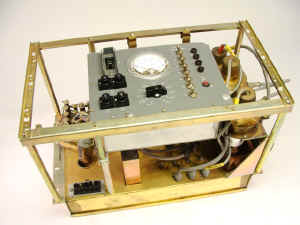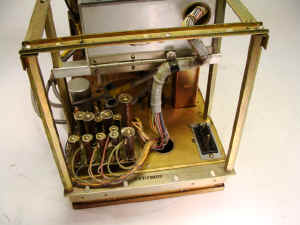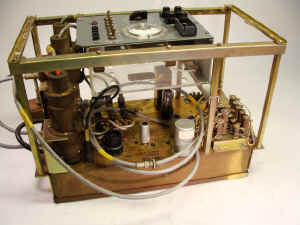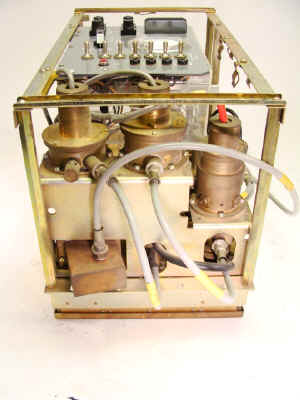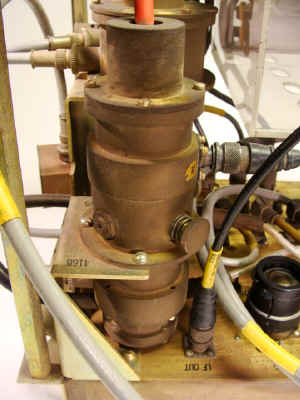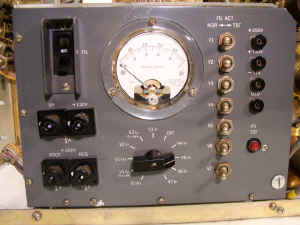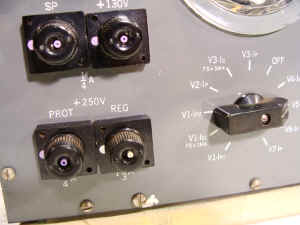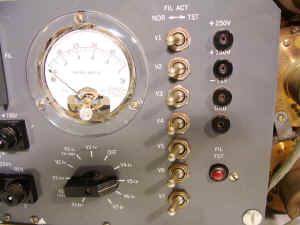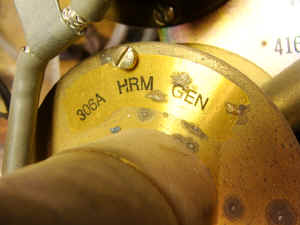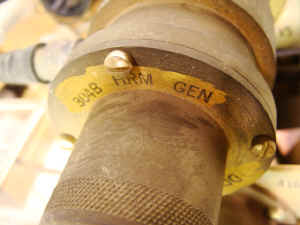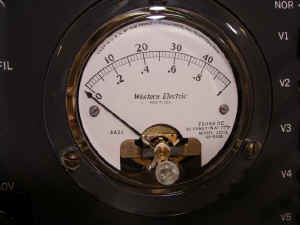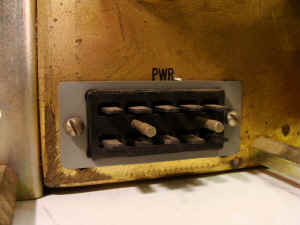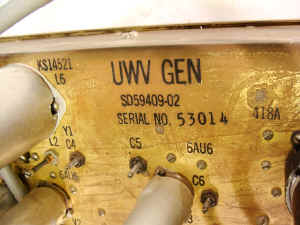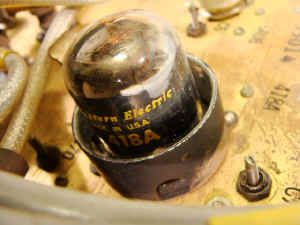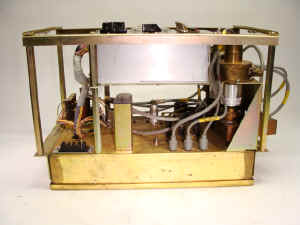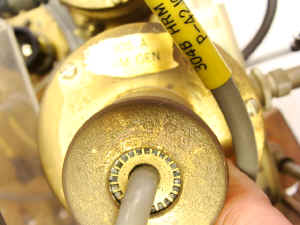|
|
A few shots of our Western Electric TD-2
UWave Generator!
This was the heart of the transmitter!
|
|
BELL LABS NEWS
PUBLISHED TWICE MONTHLY BY BELL
TELEPHONE LABORATORIES INCORPORATED
VOLUME V NO.
9
MAY 15, 1965
Time Capsule II Preserves Technical Journal Articles
Three articles from BTL's Technical Journal will be preserved for the
people of 6939 A.D. in the Westinghouse Time Capsule II. The articles are
"Automatic Switching for Nationwide Telephone Service" by A. B.
Clark and H. S. Osborne; "Nationwide Numbering Plan" by W. H.
Nunn, both from the September, 1952 issue, and "The TD-2 Microwave
Radio Relay System" by A. A. Roetken, K. D. Smith and R. W. Friis,
from the October, 1951 Technical Journal.
Time Capsule II will contain a panorama of current human activity. Its
purpose is to supplement the original time capsule buried at the first New
York World's Fair in 1938.
The new capsule is to be buried alongside the first one at the
Westinghouse World's Fair Pavilion at the end of the 1965 season.
Bell Labs scientists W. H. Brattain and C. E. Shannon will have works
included in the capsule's microfilm records as will J. Bardeen, a former
BTL scientist.
'The Transistor, A Semi-Conductor Triode," by J. Bardeen and W. H.
Brattain; and "Mathematical Theory of Communications," by C. E.
Shannon and W. Weaver, will be the works included.
The Time Capsule contents were chosen by a 14-man selections committee
headed by Dr. Leonard Carmichael, a vice president of the National
Geographic Society.
Replicas of all objects to be buried in the capsule are on display now
at the Westinghouse Pavilion at the Fair.
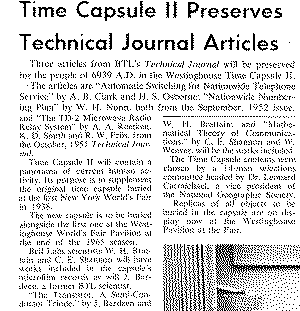
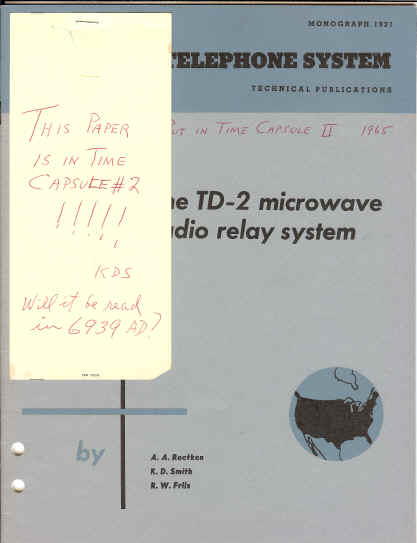
Note: K.D. Smith was the circuit design
supervisor on the TD-2 Microwave Radio Relay System. of Bell Labs
fame.
(see www.smecc.org/the_k_d__smith_collection_by_ed_sharpe.htm
to learn more about him).
He saved a
copy of the publication he helped to author on the TD-2 System. He also
saved the issue of BELL LABS NEWS with this wonder tidbit about a
copy of it being stashed away in a time capsule until 6939. Note his
card with a question as to if it would be read.....
(Items form the
K. D. Smith Collection at the Southwest Museum of Engineering
Communications and Computation) |
| |
The Westinghouse Time Capsules
"I believe that
man will not merely endure:
he will prevail."
William Faulkner
Poised against the Long Island sky, high above an open air
pavilion is suspended a slim metal tube -- shining proof that man
endures and indeed prevails.
Positioned there is a silvery duplicate of the Westinghouse
Time Capsule of the 1965-65 New York World's Fair. The torpedo-shaped
capsule will carry a message 50 centuries into the future heralding
man's unprecedented progress during the past 25 years.
Visitors passing through the pavilion pause at exhibits and
wonder what they would select for this incredible journey. What best
records the follies and fortunes of our times?
"The formation of the United Nations," offers a
well-dressed housewife from Ohio.
"A filmed record of World War II," candidly remarks a
gray-haired lumber dealer from Maine.
"A Beatles record," quips a sunburned teen-ager from
California.
Off-hand remarks like these typify the myriad opinions that
Fair visitors register as they parade through the Westinghouse Electric
Corporation pavilion. And centered above them, spurring imaginations,
is the Time Capsule, dramatically suspended 50 feet in the air from
three 100-foot pylons. At the conclusion of the Fair, the Time Capsule
will be buried on October 16, 1965 beneath the site, to be unearthed
5000 years from now. Like its sister entombed 10 feet away -- the famed
Westinghouse Time Capsule of the 1939-40 New York World's Fair -- Time
Capsule II will bring up to date the chronicle of the "history, faiths,
arts, sciences and customs" of our civilization.
If Time Capsule II represents many things to many people
today, imagine what those excavators in 6939 A.D. will think when they
discover our metal shells and this legacy we have left behind.
Travelers to the Westinghouse pavilion record their names
for reproduction on special miniaturized microfilm that will be slipped
into Time Capsule II before it is sealed, thus preserving a genealogical
record for descendents 150 generations from now. But names are
secondary; what should we leave that best mirrors the progress of those
remarkable years since the days of the Trylon and Perisphere?
From Dawn to Now...The Task Begins
That question faced Westinghouse a quarter of a century ago
as it embarked on the historic first Time Capsule project.
Let us go back to 1938 and the Westinghouse Time Capsule I.
Begin first by selecting a jury. Their task: Select the legacy.
Wading through piles of suggestions the committee assembled
a varied collection of historical material that would effectively
document our civilization as it was in 1938. Archeologists in that
unimagined future may be puzzled by what they uncover but in 1938 this
material reflected civilization as it paused briefly at a world's fair
in New York City.
A Woman's Hat and a Slide Rule
Tourists to the Fair today are amused by some of the
articles on display in one of the three exhibit areas at the
Westinghouse pavilion. Twenty-five years of accelerated living suggest
the inevitable..."Is that how we were then?"
How we were "then" is represented by dozens of articles of
common use ranging from a woman's hat to an engineer's slide rule but
not excluding a safety pin, a can opener, and a toothbrush. Also on
exhibit is a listing of 75 examples of such representative materials as
fabrics, metals, plastics and a variety of seeds. Into Time Capsule I
went these materials along with 35 articles of common use. Also
encapsulated were brief messages addressed to the future from scholars
like Dr. Einstein, physicist and creator of the Theory of Relativity,
whose equation E=mc2 was to mean so much in the ensuing years.
"See What We Did"
To cram as much material as possible into Time Capsule I the
pages of books, magazines, newspapers, circulars, catalogs and pictures
were reproduced on three and a half reels of microfilm. And the
committee foresightedly added a small viewer for reading the microfilm
was added along with instructions for making a projector. A newsreel
was added to show historic and characteristic scenes of the time -- an
address by President Franklin D. Roosevelt and a Miami fashion show.
And Only 25 Years Later...
The advent of another World's Fair and the rush of events
since 1939 launched Time Capsule II. In a quarter of a century, man
split the atom, danced the twist, ran the four-minute mile, scaled Mt.
Everest, fought another World War and began to probe space and the seas.
Dr. Leonard Carmichael, retired secretary of the
Smithsonian Institution and distinguished chairman of the Time Capsule
II Selections Committee, described the committee's function as "to make
selections to bring the 1938 Time Capsule up to date, and to aid peoples
5000 years from now in understanding our present civilization and the
rapid pace of progress that we have been experiencing."
The encyclopedic chore of selecting contents for the second
Time Capsule fell to a blue-ribbon panel of 14 Americans whose
credentials are as impressive as their assignment:
Dr. Detlev W. Bronk, President, The Rockefeller Institute,
and past President, The National Academy of Sciences
Dr. Ralph J. Bunche, Under Secretary, United Nations, and
recipient of the Nobel Peace Prize
Dr. Vannevar Bush, Honorary Chairman, Massachusetts
Institute of Technology Corporation, and former President, Carnegie
Institution of Washington
Dr. James B. Conant, former U. S. Ambassador and former
President, Harvard University
Dr. Watson Davis, Director, Science Service
Dr. Hugh L. Dryden, Deputy Administrator, National
Aeronautics and Space Administration
Dr. John Kieran, Writer and Naturalist
Dr. Henry Allen Moe, President, American Philosophical
Society
Dr. Eugene Ormandy, Music Director, Philadelphia Orchestra
Dr. Alfred Newton Richards, Pharmacologist, past President,
National Academy of Sciences
Dr. Glenn T. Seaborg, Chairman, Atomic Energy Commission,
and winner of the Nobel Prize for Chemistry
Dr. William E. Shoupp, Vice President, Research,
Westinghouse Electric Corporation
Mr. Andrew Wyeth, Artist
Assisted by four advisory subcommittees in Europe, Far
East-Oceania, Latin America and Africa-Middle East, the committee's
selections will be on cycloramic display at the Westinghouse pavilion
during the second season of the Fair. Members of the committee are
authorities in such fields as atomic energy, arts and entertainment,
commerce and industry, communications, education, the humanities, how we
live, medicine and health, science, space, sports and recreation and
world events.
As the committee began its quest, Westinghouse found itself
traversing familiar terrain and matching new technology to solve an old
question -- can the capsules last for 5000 years?
Westinghouse Research Laboratories in Pittsburgh found the
answer in a new super alloy called Kromarc. Exhaustive chemical testing
said this new stainless steel would be an excellent jacket for Time
Capsule II because of its ability to resist corrosion.
Soil samples from 50 feet below ground at the Fair site in
Flushing Meadow Park revealed that the Long Island soil is almost
completely lacking in chloride ions, a major cause of metal corrosion.
Reports Dr. F. P. Byrne, manager of the company's Research Laboratories'
analytical chemistry section: "We have concluded that there is little
possibility of severe corrosion of the Kromarc capsule by soil of such
analysis."
The Messengers
The two capsules bear many similarities. Time Capsule I was
made from a Westinghouse developed metal called Cupaloy, a copper,
chromium and silver alloy tempered to the hardness of steel. Time
Capsule I was cast in seven sections while the second Time Capsule is
constructed in three parts. The center section was cast by the U. S.
Pipe & Foundry Company of Burlington, N. J. The two bullet-shaped end
pieces were cast separately by Esco Corporation of Portland, Ore.
As with the original capsule, the contents of Time Capsule
II will be sealed inside an air-tight glass envelope. Air within the
envelope will be evacuated and replaced by an inert gas that will
prevent the contents from deteriorating. The metal capsule will then be
sealed. Protection of the contents will be insured in much the same way
as was Time Capsule I. In the case of Time Capsule I, the U. S. Bureau
of Standards examined all the materials for durability. Care was taken
not to include any objects which might produce fumes or acids capable of
attacking other articles. All liquids were ruled out and organic
objects such as seeds were hermetically sealed in glass receptacles.
Film was placed in aluminum containers and other objects were
individually wrapped in heavy rag paper and tied with linen twine.
When the packing of the inner envelope or glass was
completed, the air inside was exhausted, replaced with nitrogen, and
enough moisture injected to equal the humidity found in an ordinary
room. Then the glass envelope was heated and sealed. Finally, the
inner envelope of glass was placed in the metal shell, and the cap of
the capsule was secured to form an airtight seal.
Time Capsule II will be finally laid to rest on October 16
-- designated Time Capsule Day at the Fair. The 300-pound tube will be
provided the same survival insurance as its predecessor. Lowered in
place, the seven foot, six inch capsule will be coated with pitch,
surrounded by concrete poured down a shaft and left secure beside its
sister capsule.
Permanent Sentinel
Above the spot where the Westinghouse Time Capsules rest, a
granite monument will stand as a permanent sentinel. This memorial,
produced by The Rock of Ages Corporation, says:
The Time Capsules
Deposited
September 23, 1938
And
October 16, 1965
By The
Westinghouse Electric Corporation
As A Record Of
Twentieth Century Civilization
To Endure For 5,000 Years
A Monastery in Tibet, A Library in Manhattan
How will the capsules be found?
Some day 5000 years hence in a monastery in Tibet, or
perhaps in a library in Manhattan, a book will provide the key. The
"Book of Record," printed in 1938 on permanent paper with special ink,
describes in exact terms the latitude and longitude of the burying place
of the capsules. Some 3,000 copies of the "Book of Record" are in
libraries, museums, monasteries and other safe repositories around the
world. A supplement to the "Book of Record," announcing Time Capsule
II, will be mailed to these same locations.
In a message addressed to posterity, the book requests that
its contents be translated into new languages as they supersede the old.
Instructions for making and using instruments to locate the capsules
electromagnetically are included in the "Book of Record." It also
contains an ingenious key to the English language to aid archaeologists
of the future should knowledge of our present language be lost.
And Ahead?
And what of the years to come? A cure for cancer? Weekend
trips to the moon?
No matter to what great heights we ascend or to what great
depths we descend, we of the Twentieth Century bequeath to the
Seventieth Century proof that man not only endures, but he also
prevails.
You can be sure if it's Westinghouse
|
| |
|
Search Wikipedia!
13. Gallery
 The Westinghouse
The Westinghouse
5000 year pin award

Both Westinghouse time capsule replicas

Inspectors of the 1938 capsule

Molten cupaloy of 1938 time capsule

1938 capsule contents list

Time Capsule I (1938)

1939 capsule begins descending

1939 time capsule being lowered
13. 1. Videos
14. External links
Categories: Time
capsules, New
York City World's Fairs, 1939
in the United States, 1964
in the United States, Robert
Moses projects, 1939
architecture, 1964
architecture, Queens,
New York City, 1939
New York World's Fair, 1964
New York World's Fair
|
The Westinghouse Time Capsules
"I believe that
man will not merely endure:
he will prevail."
William Faulkner
Poised against the Long Island sky, high above an open air
pavilion is suspended a slim metal tube -- shining proof that man
endures and indeed prevails.
Positioned there is a silvery duplicate of the Westinghouse
Time Capsule of the 1965-65 New York World's Fair. The torpedo-shaped
capsule will carry a message 50 centuries into the future heralding
man's unprecedented progress during the past 25 years.
Visitors passing through the pavilion pause at exhibits and
wonder what they would select for this incredible journey. What best
records the follies and fortunes of our times?
"The formation of the United Nations," offers a
well-dressed housewife from Ohio.
"A filmed record of World War II," candidly remarks a
gray-haired lumber dealer from Maine.
"A Beatles record," quips a sunburned teen-ager from
California.
Off-hand remarks like these typify the myriad opinions that
Fair visitors register as they parade through the Westinghouse Electric
Corporation pavilion. And centered above them, spurring imaginations,
is the Time Capsule, dramatically suspended 50 feet in the air from
three 100-foot pylons. At the conclusion of the Fair, the Time Capsule
will be buried on October 16, 1965 beneath the site, to be unearthed
5000 years from now. Like its sister entombed 10 feet away -- the famed
Westinghouse Time Capsule of the 1939-40 New York World's Fair -- Time
Capsule II will bring up to date the chronicle of the "history, faiths,
arts, sciences and customs" of our civilization.
If Time Capsule II represents many things to many people
today, imagine what those excavators in 6939 A.D. will think when they
discover our metal shells and this legacy we have left behind.
Travelers to the Westinghouse pavilion record their names
for reproduction on special miniaturized microfilm that will be slipped
into Time Capsule II before it is sealed, thus preserving a genealogical
record for descendents 150 generations from now. But names are
secondary; what should we leave that best mirrors the progress of those
remarkable years since the days of the Trylon and Perisphere?
From Dawn to Now...The Task Begins
That question faced Westinghouse a quarter of a century ago
as it embarked on the historic first Time Capsule project.
Let us go back to 1938 and the Westinghouse Time Capsule I.
Begin first by selecting a jury. Their task: Select the legacy.
Wading through piles of suggestions the committee assembled
a varied collection of historical material that would effectively
document our civilization as it was in 1938. Archeologists in that
unimagined future may be puzzled by what they uncover but in 1938 this
material reflected civilization as it paused briefly at a world's fair
in New York City.
A Woman's Hat and a Slide Rule
Tourists to the Fair today are amused by some of the
articles on display in one of the three exhibit areas at the
Westinghouse pavilion. Twenty-five years of accelerated living suggest
the inevitable..."Is that how we were then?"
How we were "then" is represented by dozens of articles of
common use ranging from a woman's hat to an engineer's slide rule but
not excluding a safety pin, a can opener, and a toothbrush. Also on
exhibit is a listing of 75 examples of such representative materials as
fabrics, metals, plastics and a variety of seeds. Into Time Capsule I
went these materials along with 35 articles of common use. Also
encapsulated were brief messages addressed to the future from scholars
like Dr. Einstein, physicist and creator of the Theory of Relativity,
whose equation E=mc2 was to mean so much in the ensuing years.
"See What We Did"
To cram as much material as possible into Time Capsule I the
pages of books, magazines, newspapers, circulars, catalogs and pictures
were reproduced on three and a half reels of microfilm. And the
committee foresightedly added a small viewer for reading the microfilm
was added along with instructions for making a projector. A newsreel
was added to show historic and characteristic scenes of the time -- an
address by President Franklin D. Roosevelt and a Miami fashion show.
And Only 25 Years Later...
The advent of another World's Fair and the rush of events
since 1939 launched Time Capsule II. In a quarter of a century, man
split the atom, danced the twist, ran the four-minute mile, scaled Mt.
Everest, fought another World War and began to probe space and the seas.
Dr. Leonard Carmichael, retired secretary of the
Smithsonian Institution and distinguished chairman of the Time Capsule
II Selections Committee, described the committee's function as "to make
selections to bring the 1938 Time Capsule up to date, and to aid peoples
5000 years from now in understanding our present civilization and the
rapid pace of progress that we have been experiencing."
The encyclopedic chore of selecting contents for the second
Time Capsule fell to a blue-ribbon panel of 14 Americans whose
credentials are as impressive as their assignment:
Dr. Detlev W. Bronk, President, The Rockefeller Institute,
and past President, The National Academy of Sciences
Dr. Ralph J. Bunche, Under Secretary, United Nations, and
recipient of the Nobel Peace Prize
Dr. Vannevar Bush, Honorary Chairman, Massachusetts
Institute of Technology Corporation, and former President, Carnegie
Institution of Washington
Dr. James B. Conant, former U. S. Ambassador and former
President, Harvard University
Dr. Watson Davis, Director, Science Service
Dr. Hugh L. Dryden, Deputy Administrator, National
Aeronautics and Space Administration
Dr. John Kieran, Writer and Naturalist
Dr. Henry Allen Moe, President, American Philosophical
Society
Dr. Eugene Ormandy, Music Director, Philadelphia Orchestra
Dr. Alfred Newton Richards, Pharmacologist, past President,
National Academy of Sciences
Dr. Glenn T. Seaborg, Chairman, Atomic Energy Commission,
and winner of the Nobel Prize for Chemistry
Dr. William E. Shoupp, Vice President, Research,
Westinghouse Electric Corporation
Mr. Andrew Wyeth, Artist
Assisted by four advisory subcommittees in Europe, Far
East-Oceania, Latin America and Africa-Middle East, the committee's
selections will be on cycloramic display at the Westinghouse pavilion
during the second season of the Fair. Members of the committee are
authorities in such fields as atomic energy, arts and entertainment,
commerce and industry, communications, education, the humanities, how we
live, medicine and health, science, space, sports and recreation and
world events.
As the committee began its quest, Westinghouse found itself
traversing familiar terrain and matching new technology to solve an old
question -- can the capsules last for 5000 years?
Westinghouse Research Laboratories in Pittsburgh found the
answer in a new super alloy called Kromarc. Exhaustive chemical testing
said this new stainless steel would be an excellent jacket for Time
Capsule II because of its ability to resist corrosion.
Soil samples from 50 feet below ground at the Fair site in
Flushing Meadow Park revealed that the Long Island soil is almost
completely lacking in chloride ions, a major cause of metal corrosion.
Reports Dr. F. P. Byrne, manager of the company's Research Laboratories'
analytical chemistry section: "We have concluded that there is little
possibility of severe corrosion of the Kromarc capsule by soil of such
analysis."
The Messengers
The two capsules bear many similarities. Time Capsule I was
made from a Westinghouse developed metal called Cupaloy, a copper,
chromium and silver alloy tempered to the hardness of steel. Time
Capsule I was cast in seven sections while the second Time Capsule is
constructed in three parts. The center section was cast by the U. S.
Pipe & Foundry Company of Burlington, N. J. The two bullet-shaped end
pieces were cast separately by Esco Corporation of Portland, Ore.
As with the original capsule, the contents of Time Capsule
II will be sealed inside an air-tight glass envelope. Air within the
envelope will be evacuated and replaced by an inert gas that will
prevent the contents from deteriorating. The metal capsule will then be
sealed. Protection of the contents will be insured in much the same way
as was Time Capsule I. In the case of Time Capsule I, the U. S. Bureau
of Standards examined all the materials for durability. Care was taken
not to include any objects which might produce fumes or acids capable of
attacking other articles. All liquids were ruled out and organic
objects such as seeds were hermetically sealed in glass receptacles.
Film was placed in aluminum containers and other objects were
individually wrapped in heavy rag paper and tied with linen twine.
When the packing of the inner envelope or glass was
completed, the air inside was exhausted, replaced with nitrogen, and
enough moisture injected to equal the humidity found in an ordinary
room. Then the glass envelope was heated and sealed. Finally, the
inner envelope of glass was placed in the metal shell, and the cap of
the capsule was secured to form an airtight seal.
Time Capsule II will be finally laid to rest on October 16
-- designated Time Capsule Day at the Fair. The 300-pound tube will be
provided the same survival insurance as its predecessor. Lowered in
place, the seven foot, six inch capsule will be coated with pitch,
surrounded by concrete poured down a shaft and left secure beside its
sister capsule.
Permanent Sentinel
Above the spot where the Westinghouse Time Capsules rest, a
granite monument will stand as a permanent sentinel. This memorial,
produced by The Rock of Ages Corporation, says:
The Time Capsules
Deposited
September 23, 1938
And
October 16, 1965
By The
Westinghouse Electric Corporation
As A Record Of
Twentieth Century Civilization
To Endure For 5,000 Years
A Monastery in Tibet, A Library in Manhattan
How will the capsules be found?
Some day 5000 years hence in a monastery in Tibet, or
perhaps in a library in Manhattan, a book will provide the key. The
"Book of Record," printed in 1938 on permanent paper with special ink,
describes in exact terms the latitude and longitude of the burying place
of the capsules. Some 3,000 copies of the "Book of Record" are in
libraries, museums, monasteries and other safe repositories around the
world. A supplement to the "Book of Record," announcing Time Capsule
II, will be mailed to these same locations.
In a message addressed to posterity, the book requests that
its contents be translated into new languages as they supersede the old.
Instructions for making and using instruments to locate the capsules
electromagnetically are included in the "Book of Record." It also
contains an ingenious key to the English language to aid archaeologists
of the future should knowledge of our present language be lost.
And Ahead?
And what of the years to come? A cure for cancer? Weekend
trips to the moon?
No matter to what great heights we ascend or to what great
depths we descend, we of the Twentieth Century bequeath to the
Seventieth Century proof that man not only endures, but he also
prevails.
You can be sure if it's Westinghouse
|
| |
| |
|
